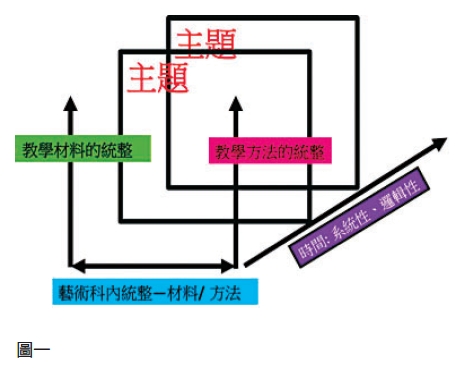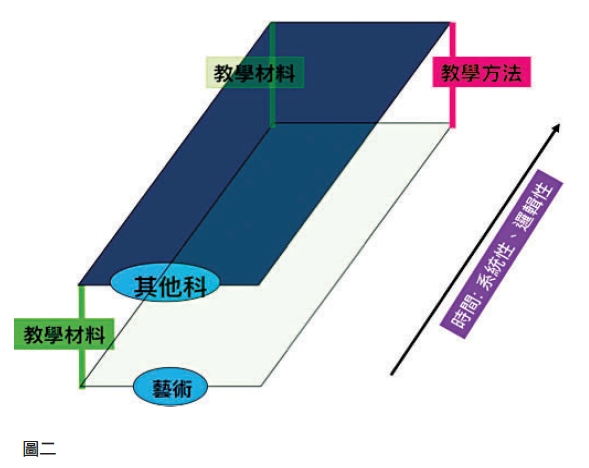Thoughts on cross-regional aesthetic feasts and home-cooked dishes
Professor Zheng Fangjing, Department of Music, National Tainan University
1. Preface
Nowadays, when it comes to "cross-field" or "cross-border", it seems that it is not exclusive to the education sector, but a fashion. The public has long regarded it as a symbol of "keeping up with the times". Of course, the art education sector also prides itself on being able to keep up with this wave. wave. In fact, from the perspective of curriculum theory, curriculum reforms in each country have their own social and historical foundations, which in turn affect the educational or teaching beliefs of educational policy makers, teachers, and educational scholars (Oliva, 2005; Cai Qingtian, 2008 ). Taiwan is naturally no exception. So, what are the current social conditions and historical tasks in Taiwan that make high-level decision-makers related to education have a sense of mission to conduct "cross-field courses" and enthusiastically take active actions? What kind of curriculum development theoretical paradigms do these curriculum leaders adopt to consolidate their persuasiveness? What kind of curriculum concepts are implemented by the following grassroots teachers?
Having been in the music education field for more than twenty years, I have watched the evolution of Taiwan's music and art education policies, from the reform of curriculum standards in 1993, to the nine-year consistent curriculum in 2000, to the fine-tuned 1997 curriculum in 2008, and now it is about to comprehensively With the implementation of the 12-year national education curriculum, we have to marvel at the rapid pace of the times.
While marveling, I often can’t help but wonder: In this rapidly changing era, is there anything that is eternal and worth sticking to? By grasping the eternal pillar, can we move more steadily towards change? Should individuals also work hard to keep up with what the public is happy with (popularity)? Or should we calmly observe whether the trend has lost its way, and be a person who reminds the public of the strength that is quietly lost? After years of advocating for integrated curriculum principles, are educators like us willing to honestly face the results and examine what abilities students have gained or lost as a result?
How to define "ability"? Is "literacy" also an ability? I remember taking a course called "musicianship" in the United States when I was young. After returning to China, in order to apply for a job, I had to translate my transcripts from my studies in the United States. I realized that musicianship should be translated as "music literacy," so I translated the course name as "music literacy training." A kind-hearted colleague corrected me and said, There are no such course titles in the music departments of universities in Taiwan. Courses that focus on basic music ability training are usually called "music basic training", "music basic ability training" or "music audio-visual training". At that time, I personally felt that the aforementioned course titles were not equivalent to the all-round, multi-faceted, and integrated musicianship training I received in the United States. However, the young rookie still chose to follow the good deeds. In this way, are "ability training" and "literacy education" the same thing? If it is really the same thing, then the framers of this wave of 12-year national education curriculum emphasize "core literacy education", which is just a swipe of Shang Fang's sword, cutting off some old words, and replacing them with some new words with the same meaning but different literal meanings. ?
The so-called "literacy" is explained in the 12-year curriculum of the Ministry of Education (2014). "'Core literacy' refers to the knowledge, abilities and attitudes that a person should possess in order to adapt to current life and face future challenges. 'Core literacy' It emphasizes that learning should not be limited to subject knowledge and skills, but should focus on the integration of learning and life, and demonstrate the overall development of learners through practice." According to personal interpretation, the goal is: not to be limited to subject knowledge and skills. , the teaching materials are combined with life content to teach citizens with full personality who have the knowledge, abilities and attitudes to adapt to life and face the future. The words "not limited to subjects..." and "integrated with life" point out that "cross-field" or "integrated" courses or teaching strategies can occasionally be used for curriculum planning, but after all, we still expect the national Acquire "knowledge", "ability" and "attitude" through school education. The question is, why is there such an emphasis on "literacy" as if it is a new concept? In which era was this not the goal of national education? Which Chinese teacher with a sense of mission does not expect this to be the teaching goal? How or who will define what knowledge, abilities and attitudes are effective in adapting to life and facing the future? This seems to return to the issue raised by H. Spencer (Wang Wenke, 2007) at the end of the 19th century regarding the value of school curriculum.
At this point in writing, it seems that "the constant in change" is looming.
The author is fortunate to participate in the promotion of the 2016 and 2017 "Ministry of Education's Cross-disciplinary Aesthetic Education Experimental Curriculum Development Plan for Secondary Schools and Elementary Schools". In order to promote the spirit of cross-disciplinary courses in the school, professors from non-art departments were invited to join the ranks of promotion and consultation, but some teachers refused. So some "cross-domain" and "non-cross-domain" conversations started. The author has benefited a lot, and it has inspired me to re-examine my educational beliefs. In addition, I observed the cooperative schools participating in the experimental courses exploring the practice of cross-field courses combined with aesthetics. Their implementation methods, product outputs, and plan structures... are really diverse. One can't help but admire the vitality, educational enthusiasm, and creativity of frontline teachers. It also benefits from the depth and breadth of the author's personal perspective when exploring this issue.
In the following, based on what I have thought and observed above, I will reduce the cross-field aesthetic course into "big meals" and "home-cooked meals" for discussion.
2. Cross-regional feast of aesthetic literacy
In the three semesters from 2017 to 2018, the author contacted and observed that many partner schools or seed schools participating in experimental courses all implemented a cross-field course plan in one semester, and some of the implemented semesters took several classes to complete one Some schools use a whole semester to achieve a practical goal. However, most schools target the classes taught by a certain teacher and the teachers he collaborates with. Some have only one class (such as music and art talent classes, and a class chosen by the teacher personally), some have several classes, and some have The school is a group experience for all grades. The result of the project is usually the output of a finished product with certain artistic attributes, such as a wall, a work (or a type of work), a play, a book, a performance... the teacher guides students to observe the production process of the finished product. The thinking is combined with local culture, life education, mathematical concepts, social issues, historical knowledge, scientific and technological applications, etc. The teachers used all their energy to invite friends to prepare courses, collaborate on teaching, think about themes, explore teaching strategies and models, and finally achieved a dazzling exhibition or performance. Their creative ideas really put the author to shame.
Out of envy, I started a dialogue with the school and teachers to explore the joys and sorrows of implementing cross-field curriculum. Those who are happy mostly refer to the improvement of students' learning attitude and sense of accomplishment in completing a large performance or work due to the changes in the way the courses are conducted; those who are miserable are those who have affected the normal course progress, a lot of extra work that is tiring, and no courses. The module can be applied and you just have to try and figure out whether it is right or not. The banquet-style cross-domain courses are splendid and dazzling, but at the same time they make many teachers exhausted. Now that they are tired, they are less willing to implement them for a long time. It is like holding a big banquet to death and not wanting to hold banquets every day. . However, "can be implemented on a regular basis" is the focus of this experimental course plan, that is, it is expected to become a regular course so that all students have the opportunity to benefit. In other words, the purpose of education is never to cross fields for the sake of cross-fields. . If you think about it carefully, even if art courses are highly inclusive and can be easily used as a learning medium for other subjects (Zhao Huiling, 2016), implementing a cross-domain aesthetics course with one theme for a few weeks or even a whole semester is really beneficial to the student system. Sexual and sequential learning objectives?
Observed from the perspective of curriculum development and design, most of the feast-style plans are value-oriented or process-oriented, breaking away from the traditional teaching content or structure, in an attempt to gain some new gains in Lao Shen's teaching context. However, the orientation of curriculum development and design is based on several theories, such as the more scientific structure-oriented theory and content-oriented theory, the more humanistic value-oriented theory, and the process-oriented theory. Teachers do not necessarily need to understand these theories, but based on my personal observation, I found that teachers in China already have humanistic thinking and practice it in their courses. However, what is paradoxical is that more than half of the schools use finished products as a representation of the results of course practice, and seem to focus more on summative assessment than on formative assessment in the process. On the other hand, since most curriculum models tend to focus on value reconstruction and process, it also means that structure and content may be ignored, leaving students with loose learning content.
In addition to the general environment, such as historical background and social conditions, the evolution of general curriculum is also the basis of teachers' curriculum psychology. R. Tyler regarded this foundation as the "filter" for setting the tone of the curriculum (Oliva , 2009). Educational psychology has influenced the curriculum from the behaviorism of the early 20th century, the cognitive development of the 1960s, the constructivism and humanism of the 1970s, and the curriculum propositions of multiple intelligences and conceptual reconstructionism after the 1980s. All of these can be seen in the dazzling applications of teachers in this wave of experimental course plans. It can be seen that domestic teachers are professional in terms of personal theoretical equipment. Therefore, the course content and teaching strategies written in the plan are also exciting.
However, no matter how open-ended or deconstructive a wonderful course is, if it wants to become a normal teaching, it must face the evaluation of effectiveness. As the curriculum and teaching propositions of each school differ, the content of their so-called assessments also differs, but they all have their depth. The behaviorist R. Gagne (Zhang Chunxing, 2013) learning hierarchy and the learning hierarchy in B. Bloom's learning proficiency learning theory (Ye Chongqing, 2011), which is widely used in the domestic education circle, can provide teachers with the opportunity to plan teaching. The target points to be achieved, as well as considerations when considering the level and content of assessment of students’ abilities after teaching. The curriculum also encourages teachers to use multiple assessments (Ministry of Education, 2017: 33) to evaluate the effectiveness of courses and teaching, as well as to evaluate students' learning effectiveness. The author observes many programs and finds that the assessment methods and tools used are often clearly mentioned in the content, but few evaluate the courses themselves. What is even more confusing is that under the integrated teaching of multiple subjects across fields, which subject should students' learning effectiveness be evaluated? Have students’ “knowledge, abilities and attitudes to adapt to life and face the future” increased as a result?
An advisory committee member said in the forum (2018.6.8 NTU Teacher Forum) that he was always puzzled, "If you cross the undergraduate course, you will disappear..."; many other teachers mentioned that students' basic subject skills are weak, which makes it difficult for students to cross subjects. The teaching goal is difficult to achieve, so it is advocated to postpone cross-field teaching and replace it with strengthening students' learning of basic skills. Apparently some scholars or teachers have not seen that "Irwin, Gouzouasis, Leggo, Springgay (2006), Gullatt (2008), etc. pointed out that the teaching method of integrating art with other subjects has an impact on the subject abilities of individual learners at all ages. Positive help.” (Zhao Huiling, 2016) However, this statement is indeed worthy of educators stopping and thinking for a moment.
Ginseng and aesthetic literacy cross-regional home cooking
The nature of art is complex and diverse, and the construction of its abilities (knowledge, skills, attitudes) requires long-term and continuous accumulation. The so-called improvement of aesthetic ability refers to the aesthetic experience multiplied by aesthetic literacy and aesthetic response, which is by no means achieved overnight (Meyer, 1998). The independent study of each subject is still the foundation of the curriculum. Therefore, although the art field of the 12 national education syllabus integrates the three major subjects into one field, the standards of learning content are still listed in each subject.
If the planning and implementation of the curriculum clearly focus on the teaching of basic skills, the author calls it home cooking. This form of curriculum, among the schools observed in the past two years, some primary and secondary schools implemented cross-field curriculum with the hope that it will become the norm for the whole school. In other words, the target is the whole school or the whole grade, the period is continuous rather than temporary, and the goal is students' systematic learning. However, in the course of course practice, teaching is occasionally conducted in a cross-field manner based on seasons, events, issues, or a specific subject. The progress of each discipline has not been delayed because of this, and most of the results are performances and works, but there are also those who seek additional learning content in each subject without specific output. I remember that there was a primary school that participated in a cross-disciplinary aesthetic experimental course. The principal led teachers from all subjects, restaurants and health centers to join in. The theme of the semester was "Integration with the Local", and teachers from each subject integrated this theme into regular courses. In the content, there is no special finished product at the end of the semester, it is just used to activate the tangible and intangible teaching of the school that semester. As for assessment, teachers in each subject still clearly focus on the original assessment of each subject. At most, the assessment content adds additional cross-field related learning content. However, it is still difficult for the author to judge whether the students' aesthetic literacy has been improved as a result? But what is certain is that all the students in the school have learned more about local characteristics through the cross-American courses this semester. Their aesthetic experience through the study of art-related courses must be more connected with local elements. Linhai Elementary School, another rural area, combined the theme of Mother's Day over a four-week period and integrated visual arts (making gratitude cards), Chinese language (writing gratitude poems), and music (for foreign mothers, or those who raised them across generations). Grandpa and grandma sing sentimental songs in Vietnamese and Taiwanese, their mother tongues), society (carry out fish village street parade, send gratitude cards from door to door, sing gratitude songs), performance (street parade performance), although the results of the school’s implementation of the curriculum are not Brilliant works or performances, but watching the school’s video presentation on Facebook was very moving. I can’t help but ask myself, isn’t the ultimate goal of education. Improve people's spirituality?
However, when it comes to course performance, according to the implementation reports written by these schools that implement home-cooked cross-disciplinary courses, although the evaluation methods and tools used are clearly listed, there is still little evaluation of the course itself, and it is difficult to judge the beauty of students. The degree of growth of literacy. In terms of the orientation of curriculum development and design, this home-cooked cross-disciplinary course not only emphasizes humanistic values, but also adheres to the original content and structure of each subject's curriculum, but through cross-disciplinary strategies, it attempts to inspire all Students' learning motivation and active subject teaching have a multiplier effect on students' learning. No wonder the principals and teachers of such schools expressed the hope that they can receive funding in the future to continue such cross-field aesthetics. course.
4. Four-dimensional actions of cross-domain integration
Zhao Huiling pointed out (2016) based on the propositions of Burton, Abeles, and Horowitz (2000), “Due to the complexity and diversity of artistic activities themselves, the curriculum construction methods in the art field are extremely diverse. In addition to being an independent learning field, it can also Different levels of integration with other subject areas. The author also believes that appropriate integrated curriculum formats do have a multiplier effect on student learning. However, Wang Wenke (2007) once discussed the review of Taiwan's curriculum design model. Mentioned that in the wave of educational reforms that have been carried out since the nine-year curriculum, "integration" is a very loud term, but it is easily misunderstood, causing deviations in curriculum development design or teaching actions. In Taiwan's education field, where higher education is the main focus, art subjects have long been marginalized. Now it is really good to see art educators taking the initiative to clear the air and use a cross-field approach to give art disciplines the opportunity to receive more attention and application. But integration is definitely not the ultimate goal of education. In order to prevent teachers from falling into the unwarranted busyness of "integrating for the sake of integrating and crossing fields for the sake of crossing fields," the author, based on many years of personal observation and practice, believes that if there is a good four-dimensional foundation for integration (Figure 1 ), you can have the effect of home cooking and a feast.
(1) In the time dimension, the content, system and teaching sequence of a single subject are integrated. This is a basic skill that requires a lot of time to learn and accumulate artistic aesthetic experience under the complete course content and structure.
(2) In terms of teaching materials, cross-subject or cross-domain integration should be carried out according to the content of the teaching materials. The most common is teaching English through music; another example is teaching that integrates music and vision through sensory elements of music and visual art.
(3) In the dimension of teaching strategies, that is, due to the needs of the teaching objectives of a specific subject, the strategy uses art as an activated teaching medium for cross-subject or cross-domain integration. Or in the opposite direction, the teaching of other subjects can deepen the depth of learning in art subjects.
(4) In terms of themes or issues, plan and integrate courses based on different disciplines or fields. This is the most common type in China in the past ten years.
Among the four dimensions above, if the school focuses on the three dimensions (1), (2), and (3), and takes aesthetic literacy as the axis, it will be a cross-disciplinary course on aesthetic home-cooked dishes; if a certain theme is combined with multiple subjects Conducting more complex integration courses is what the author calls a cross-domain aesthetic feast course. With home-cooked courses that take care of basic skills, and occasionally lively and innovative meals, students' learning results will definitely be improved and multiplied (Figure 2).
5. Conclusion
"The goal of literacy education is not limited to subject knowledge and skills. The teaching materials are combined with life content to teach citizens with full personality who have the knowledge, abilities and attitudes to adapt to life and face the future" (Ministry of Education, 2014). It is actually for all The country has a common educational goal at any time. The only difference is that the design and development models or strategies of the curriculum structure and teachers' teaching strategies will differ due to history, social conditions, and teachers' personal preferences. From the perspective of the art field, whether art subjects are used to activate other subjects, or combined with other subjects to enhance the depth and breadth of art learning, what ultimately matters is the growth of students' "aesthetic literacy." For example, Zhao Huiling (2016) defined "cross-disciplinary aesthetic courses" as using artistic media, artistic concepts, aesthetic elements and artistic resources as media, resources, strategies and main axes to activate, assist and integrate learning in other disciplines to construct "art-based courses". "Cross-disciplinary courses" as the core. Since "art is the core", the focus of curriculum evaluation or teaching evaluation must be "aesthetic literacy". However, in the past two years, the author has observed the curriculum plans of cooperative schools or seed schools. It is true that the evaluation of aesthetic literacy is not implemented much, or it is superficial. According to the author's observation, there are two reasons for this: First, the so-called beauty is so infinitely summarized that it is difficult to evaluate, such as the beauty of life and the beauty of morality... These are actually things that need to be integrated into every subject of school education, and are not exclusive art courses; Secondly, after combining multiple subjects across fields, the teaching objectives are out of focus, or they may only focus on the final performance, thus neglecting the specific learning effects of students' aesthetic literacy.
The author believes that if the aesthetic curriculum in national schools is compared to a healthy diet, then the healthiest aesthetic curriculum should focus on the aesthetic curriculum of home-cooked dishes that is light but solid and balanced on weekdays, and then plan a flexible teaching aesthetic curriculum at least once every school year. Field feast. It is hoped that such courses can benefit every student on a regular basis.
This article is included in "What Class Is This - Imagination and Practice of Cross-Field Aesthetics Courses", Taipei: National Taiwan Normal University, 2018





